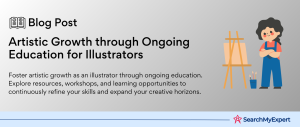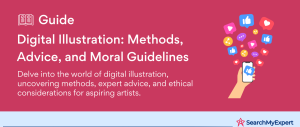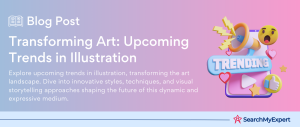The Expansive World of Illustration: A Gateway to Diverse Opportunities
The field of illustration is a dynamic and evolving art form that transcends traditional boundaries, offering a unique blend of creativity and storytelling. This visual communication tool is not only about creating appealing images but also about conveying messages and ideas engagingly and effectively. Its versatility allows for application across various industries, making it an increasingly in-demand skill in our visually-driven world.
The purpose of this presentation is to delve into the diverse markets and potential opportunities available for illustrators. We aim to explore how this creative field intersects with different industries, highlighting the vast array of avenues where illustrators can apply their skills and thrive. This exploration is not just about understanding where illustrators fit into the current market but also about uncovering emerging opportunities and trends that could shape the future of illustration.
Versatility of Illustration in Today’s Market
Illustration is an art form that adapts to the needs and trends of the time. With the advent of digital technology, the scope of illustration has broadened, encompassing areas such as digital design, animation, and multimedia arts. Traditional illustration, with its roots in drawing and painting, continues to be revered and utilized, often merging with digital techniques to create hybrid forms of art.
Illustrators today find themselves working in diverse settings – from publishing houses and advertising agencies to gaming studios and fashion brands. Each industry presents unique challenges and opportunities, requiring illustrators to be versatile in their approach and adaptable in their style. This adaptability is key to thriving in a market where trends and technologies are constantly evolving.
Exploring Markets for Illustrators
Our exploration will focus on identifying and understanding the key markets for illustrators. These include, but are not limited to:
- Publishing:
Here, illustrators breathe life into stories, creating book covers, children’s book illustrations, and graphical elements for educational materials. - Advertising and Marketing:
Illustrators in this field create compelling visuals for campaigns, product packaging, and branding efforts. - Digital Media:
This rapidly growing sector involves creating artwork for websites, apps, and social media platforms. - Entertainment and Gaming:
Illustrators here work on character design, background art, and visual storytelling for video games, movies, and television. - Fashion and Textiles: This niche market involves creating patterns and designs for fabrics, apparel, and accessories.
- Editorial:
Illustrators contribute to magazines, newspapers, and online publications, often creating visuals that complement or enhance written content.
Traditional Illustration Markets: A Deep Dive into Publishing, Advertising, and Editorial Illustration
Publishing: Illustrating the Pages of Imagination and Knowledge
In the publishing industry, illustration plays a crucial role in engaging readers and enhancing the textual content. This market is diverse, encompassing children’s books, textbooks, magazines, newspapers, and book covers, each requiring a unique illustrative approach.
- Children’s Books:
Here, illustrations are not just visual aids but integral storytelling elements. They provide context, evoke emotions, and aid in the development of a child’s imagination. Successful children’s book illustrators understand how to create relatable characters and settings, often using vibrant colors and imaginative scenarios. It’s a collaborative process where illustrators work closely with authors and publishers to bring stories to life. - Textbooks:
In educational publishing, illustrations are used to clarify complex concepts, making them accessible to students of all ages. This requires a precise and informative approach, often involving diagrams, charts, and detailed artwork. The challenge lies in simplifying information without losing its essence, making it a rewarding field for illustrators who enjoy the blend of art and education. - Magazines and Newspapers:
Illustration in periodicals often serves to complement and enhance articles, offering a visual break from dense text. This could range from small-spot illustrations to full-page artwork. The key is to create images that are not only attractive but also convey the essence of the accompanying article. - Book Covers:
A book cover is often the first point of interaction between a book and its potential reader. Illustrators in this niche need to encapsulate the theme and mood of the book in a single, compelling image. It’s a challenging task that requires a deep understanding of the book’s content and the market it aims to attract.
Advertising: The Art of Selling through Illustration
In advertising, illustrations are used to create eye-catching and memorable visuals that promote products, services, or ideas. This market is highly dynamic and competitive, requiring illustrators to be innovative and adaptable.
- Print Ads and Billboards:
These traditional forms of advertising rely heavily on visual appeal. Illustrators create striking images that capture the viewer’s attention and convey the brand’s message succinctly. The challenge is to create artwork that stands out in a crowded visual landscape. - Packaging: Product packaging is another crucial area where illustrations can make a significant impact. An illustrator’s job is to design packaging that is not only functional but also visually appealing, helping the product stand out on the shelves. This often involves creating thematic illustrations that resonate with the brand identity and appeal to the target audience.
- Marketing Materials:
This includes brochures, flyers, posters, and other promotional items. Illustrators work to create cohesive and appealing designs that align with the brand’s image and marketing goals. The artwork must be engaging and convey the intended message effectively to potential customers.
Editorial: Conveying Ideas Through Art
Editorial illustration is about encapsulating stories or concepts in a single, impactful image. This market is vast, covering cartoons, comics, infographics, and illustrations for articles.
- Cartoons and Comics:
These are powerful mediums for storytelling and social commentary. Illustrators in this field must have a strong sense of narrative, character design, and often, a knack for humor. They need to convey complex ideas or stories in a few panels, making every line and color count. - Infographics:
Infographics blend data and design, presenting information in a visually engaging and easily digestible format. Illustrators must work with data and text, transforming them into compelling visual narratives. This requires a keen eye for design and an ability to simplify complex information. - Editorial Illustrations:
These are used in magazines and online publications to complement articles, often adding a new dimension to the written content. The illustrator’s task is to interpret the essence of the article and represent it visually, often under tight deadlines.
Digital Illustration Markets: Navigating the Web of Creativity and Technology
In the digital age, illustration has found new avenues and platforms, expanding its reach and impact. The advent of digital tools and software has revolutionized the way illustrations are created and consumed, opening up a myriad of opportunities in web and app design, motion graphics, and online editorial content.
Web and App Design: Crafting the Digital Experience
The digital landscape is heavily reliant on visual appeal and user experience, making illustration an essential component in web and app design. In this domain, illustrators contribute to creating a visually engaging and intuitive user interface (UI) and user experience (UX).
- UI/UX Illustrations:
These are crucial in making digital platforms user-friendly and appealing. Illustrators create elements that guide users through an app or website, such as icons, buttons, and other navigational aids. The challenge is to blend aesthetic appeal with functionality, ensuring that the illustrations enhance the user experience rather than distract from it. - Icons and Infographics: Custom icons and infographics in digital platforms help convey information efficiently and engagingly. They are used to break down complex information, guide users, and enhance the overall aesthetic of the digital product. The creation of these elements requires a combination of graphic design skills and artistic creativity.
- Character Design:
For apps and websites with a narrative or branding element, character design becomes an integral part of the illustration process. These characters often become the face of the platform, creating a memorable and relatable experience for the users.
Motion Graphics: Bringing Illustrations to Life
Motion graphics is a rapidly growing field where illustrations are set in motion, creating dynamic and engaging visual content. This market includes animated explainer videos, social media animations, and video game art.
- Animated Explainer Videos:
These videos are a popular tool for businesses and educational platforms, used to explain concepts, products, or services. Illustrators in this field create the visual elements that are then animated, requiring a strong understanding of storytelling and visual communication. - Social Media Animations: With the rise of social media, animations have become a powerful tool for engagement. Illustrators create short, eye-catching animations that are designed to capture the viewer’s attention in a short span, often to convey a message or promote a brand.
- Video Game Art:
In the gaming industry, illustrators are involved in creating everything from character designs and environments to UI elements. This requires not only artistic skills but also an understanding of the gaming world and its audience.
Editorial: The Digital Turn in Publishing
The shift to digital has transformed the editorial industry, with online articles, website banners, and e-book illustrations becoming increasingly prevalent.
- Online Articles:
Similar to traditional publishing, digital articles often feature illustrations to enhance the content and engage readers. The digital platform allows for more flexibility and creativity, with the potential for interactive and animated illustrations. - Website Banners: These are key visual elements on websites, often the first thing a visitor sees. Illustrators create banners that not only capture the essence of the website or the featured content but also encourage viewers to explore further.
- E-book Illustrations: With the rise of digital reading, e-books have become a popular format. Illustrators in this market create images that are optimized for digital screens, considering factors like layout, color, and readability on various devices.
Niche Illustration Markets: Specialized Artistry Meeting Unique Demands
The world of illustration is not just limited to mainstream markets; it also thrives in niche areas where specialized skills and unique artistic approaches are in high demand. In this exploration, we delve into the niche markets of scientific illustration, fashion design, and specialized editorial illustration, each offering distinct opportunities and challenges for illustrators.
Scientific Illustration: Visualizing the Complexities of Science
Scientific illustration is a field where art meets science, requiring a precise and accurate portrayal of scientific subjects. This niche market is essential in making complex scientific concepts accessible and understandable.
- Medical Illustrations:
These are vital in the medical and healthcare industries for educational purposes, patient care, and research. Medical illustrators create detailed and accurate representations of anatomical structures, surgical procedures, and medical conditions. This requires a deep understanding of human anatomy and medical terminologies, alongside artistic skills. - Biological Diagrams: Illustrators specializing in biology create diagrams that depict various biological processes and structures, from cellular mechanisms to ecosystem layouts. These illustrations are crucial for textbooks, research papers, and educational materials, requiring a balance of scientific accuracy and visual clarity.
- Educational Materials:
Scientific illustrators also contribute to creating visuals for educational content, including textbooks, interactive learning modules, and museum exhibits. Their work helps in breaking down complex scientific ideas into engaging and comprehensible visual formats for learners at all levels.
Fashion Illustration: The Art of Style and Trends
Fashion illustration is a creative field where artistry and fashion design converge. Illustrators in this niche create visuals that capture the essence of style, trends, and clothing design.
- Textile Design: This involves creating patterns and designs for fabric used in fashion and interior design. Illustrators work on a variety of patterns, from floral and geometric to abstract designs, understanding how these patterns will translate onto fabric.
- Printmaking for Fashion: Fashion illustrators also engage in printmaking, creating unique prints for clothing lines. This requires an understanding of fashion trends, fabric types, and printing techniques.
- Footwear and Accessory Design: Illustration plays a key role in designing footwear and fashion accessories. Illustrators in this sector must be aware of fashion trends, materials, and the functionality of designs, creating illustrations that are both aesthetically pleasing and practical.
Editorial Illustration: Telling Stories through Specialized Art
In the editorial realm, niche illustration takes the form of caricatures, portraits, editorial cartoons, and graphic novels. These forms of illustration are powerful tools for storytelling and commentary.
- Caricatures and Portraits:
These are often used in magazines, online platforms, and political commentary, capturing personalities or conveying messages through exaggerated features or symbolic representation. This requires a keen eye for detail and a unique artistic style. - Editorial Cartoons:
These offer visual commentary on current events, politics, and social issues. Editorial cartoonists must be adept at conveying complex ideas and opinions through simple yet impactful images. - Graphic Novels: This market combines art and narrative storytelling, creating compelling visual stories. Graphic novel illustrators need to be skilled in character design, scene setting, and visual narrative flow.
Emerging Illustration Opportunities: Navigating the Future of Art and Design
The illustration industry is continuously evolving, adapting to technological advancements and changing market dynamics. Emerging opportunities in fields like NFTs and the Metaverse, personal branding, and self-publishing are creating new platforms and avenues for illustrators to showcase their talent and monetize their art.
NFTs and the Metaverse: Pioneering Digital Art in New Realms
The rise of blockchain technology has introduced the world of Non-Fungible Tokens (NFTs) and the Metaverse, offering groundbreaking opportunities for illustrators.
- Creating and Selling Digital Artwork as NFTs:
NFTs have opened a new marketplace for digital artists and illustrators. By tokenizing their artwork, illustrators can sell their digital creations as unique, verifiable assets, often garnering significant attention and value. This market values originality and innovation, offering a new revenue stream for digital artists. - Character Design for Virtual Worlds:
The Metaverse, a collective virtual shared space, is rapidly expanding. Illustrators are finding opportunities in designing characters, environments, and assets for these virtual worlds. This requires not only artistic skill but also an understanding of 3D modeling and virtual reality environments.
Personal Branding: Crafting Visual Identities for Brands and Individuals
In the era of digital marketing and social media, personal branding has become crucial for businesses and individuals. Illustrators play a key role in creating unique visual identities.
- Illustrating Logos and Brand Mascots: A well-designed logo or a memorable mascot can significantly impact a brand’s identity. Illustrators in this field create custom designs that resonate with the brand’s values and appeal to its target audience.
- Websites and Social Media Assets: The visual appeal of websites and social media platforms is vital in attracting and retaining audience attention. Illustrators create bespoke illustrations, banners, and other visual elements that enhance online presence and engagement.
- Designing for Influencers and Personal Brands: With the rise of influencers and personal branding, there is a growing demand for custom illustrations that reflect an individual’s personality and brand message. This can include everything from portrait illustrations to custom content for social media.
Self-Publishing: Empowering Artists to Tell Their Own Stories
The growth of self-publishing platforms has provided illustrators with an avenue to independently create and publish their work.
- Designing and Illustrating Children’s Books: Self-publishing has opened doors for illustrators to bring their own children’s book ideas to life. This allows for complete creative control, from the storyline to the illustration style.
- Comics and Graphic Novels:
For illustrators with a passion for storytelling, self-publishing offers the opportunity to create and distribute their own comics or graphic novels. This market appreciates unique art styles and storytelling approaches.
Navigating the Market and Finding Clients: Strategies for Illustrators
In the diverse world of illustration, finding success often depends on more than just artistic talent. It involves understanding the business side of art, including market navigation, client acquisition, and professional networking. This section focuses on practical strategies for building a strong portfolio, enhancing online presence, effective networking, understanding legal aspects, and setting competitive rates.
Building a Strong Portfolio and Online Presence
A compelling portfolio is an illustrator’s most powerful tool in attracting clients. It should showcase your best work, diversity of skills, and unique style.
- Diverse Portfolio:
Include a variety of work that demonstrates your range and versatility. Tailor your portfolio to the type of clients or industries you’re targeting, whether it’s children’s book publishers, advertising agencies, or digital media. - Online Presence: In today’s digital age, an online portfolio is crucial. Platforms like Behance, Dribble, or a personal website can showcase your work to a global audience. Regularly update your online portfolio and utilize SEO strategies to improve visibility.
- Social Media Engagement: Platforms like Instagram, Twitter, and LinkedIn can be effective tools for showcasing your work and connecting with potential clients. Regular posts, engaging with followers, and using relevant hashtags can increase your reach.
Networking with Industry Professionals
Building professional relationships is key to finding opportunities in the illustration market.
- Editors and Art Directors: Connect with editors and art directors from publishing houses, magazines, and online platforms. Attend industry events, book fairs, or art exhibitions to meet these professionals in person.
- Creative Agencies:
Agencies often look for freelance illustrators for various projects. Research agencies that align with your style and approach them with your portfolio. - Online Forums and Communities: Participate in online forums, webinars, and communities related to illustration. These platforms can offer valuable insights and connections.
Understanding Licensing Agreements and Contracts
Knowledge of the legal aspects of illustration is vital in protecting your rights and ensuring fair compensation.
- Licensing Agreements: Understand the different types of licensing agreements – exclusive, non-exclusive, and rights-managed. Know what rights you are granting to the client and for how long.
- Contracts:
Always work with a contract that clearly outlines the project scope, deliverables, timelines, revisions, payment terms, and copyright ownership. Consider consulting a legal professional for contract reviews.
Setting Competitive Rates and Negotiating Fees
Determining your pricing is crucial in sustaining your illustration career.
- Research Market Rates:
Understand the going rates for different types of illustration work. Consider factors like your experience, project complexity, and usage rights. - Transparent Pricing: Be clear about your pricing structure. Whether you charge per project, per hour, or have a day rate, make sure it’s communicated clearly to the client.
- Negotiation Skills:
Be prepared to negotiate fees. Understand your minimum acceptable rate and be willing to discuss terms that are beneficial for both you and the client.
Embracing the Vast World of Illustration
As we reach the conclusion of our exploration into the field of illustration, it’s clear that this creative domain is rich with diverse opportunities. From the traditional realms of publishing and advertising to the emerging digital platforms like NFTs and the Metaverse, illustration offers a spectrum of pathways for artistic expression and career development.
The field of illustration is continually evolving, mirroring changes in technology, media, and consumer preferences. This dynamic nature of the industry presents illustrators with the challenge and opportunity to continuously adapt and innovate. Whether it’s through mastering digital tools, exploring new markets, or refining their artistic voice, there’s always room for growth and discovery in this field.
Encouragement for Aspiring Illustrators
For those aspiring to build a career in illustration, the journey is as rewarding as it is challenging. The key to success lies in developing your skills, finding your niche, and being adaptable to the changing market needs. Embrace the process of learning and experimentation, as it is crucial in finding your unique style and voice in this competitive field.
Building a successful career in illustration also involves understanding the business aspects, from networking and marketing yourself to navigating contracts and setting appropriate rates. Balancing your artistic passion with practical business skills is essential for a sustainable and fulfilling career.
Resources and Support for Illustrators
- Online Courses and Workshops:
Platforms like Skillshare, Udemy, and Coursera offer a variety of courses in illustration techniques, digital tools, and business skills for artists. - Industry Conferences and Events:
Attending events like ICON Conference, Society of Illustrators’ events, or local art fairs can provide valuable networking opportunities and industry insights. - Online Communities and Forums:
Joining communities such as the Association of Illustrators or online forums can offer support, advice, and connections within the industry. - Books and Publications: Books such as “The Illustrator’s Guide to Law and Business Practice” or “Color and Light: A Guide for the Realist Painter” can be valuable resources for both artistic and business aspects of illustration.
- Mentorship:
Seeking mentorship from established illustrators can provide guidance, industry insights, and support as you navigate your career.
Conclusion:
In the multifaceted and vibrant world of illustration, opportunities abound for those with a passion for art and storytelling. This field, ever-evolving with technology and market trends, offers a canvas for creativity across various domains like publishing, advertising, digital media, and more. For aspiring illustrators, the key to success lies in continual skill development, finding a unique niche, and understanding the business aspects of the art world. From traditional methods to innovative digital platforms, the illustration industry invites you to explore its depths and leave your mark. Embrace the journey of discovery and innovation, and you may find yourself at the forefront of this exciting and rewarding field.
Stand out with unique artwork from our Illustrators Firms.
Table of Contents
Toggle






